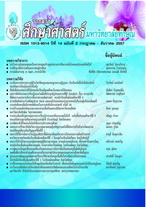การประเมินหลักสูตรกลุ่มสาระการเรียนรู้การงานอาชีพและเทคโนโลยี ระดับชั้นประถมศึกษาปีที่ 6 ของเครือข่ายสถานศึกษาท่าชะมวงสามัคคี อำเภอรัตภูมิ จังหวัดสงขลา
Main Article Content
บทคัดย่อ
บทคัดย่อ
งานวิจัยนี้มีวัตถุประสงค์ เพื่อประเมินหลักสูตรกลุ่มสาระการเรียนรู้การงานอาชีพและเทคโนโลยี ระดับชั้นประถมศึกษาปีที่ 6 ของเครือข่ายสถานศึกษาท่าชะมวงสามัคคี อำเภอรัตภูมิ จังหวัดสงขลา โดยประยุกต์ใช้แนวคิดของDanial L. Stufflebeam (CIPP Model) และภาคขยายเป็น(CIPIEST) ซึ่งประเมินในด้านบริบท ด้านปัจจัยเบื้องต้น ด้านกระบวนการ ด้านผลกระทบ ด้านประสิทธิผล ด้านความยั่งยืน และด้านการถ่ายทอด/ขยายผล กลุ่มตัวอย่างที่ใช้ในการประเมิน คือผู้บริหาร 7 คน ครูผู้สอน 7 คน คณะกรรมการสถานศึกษา 59 คน ผู้ปกครอง 136 คน วิทยากรในท้องถิ่น 2 คน และนักเรียน 136 คน เครื่องมือที่ใช้ในการประเมินประกอบด้วย แบบบันทึกผลการศึกษาเอกสารหลักสูตร แบบสอบถามนักเรียน แบบสอบถามคณะกรรมการสถานศึกษาและผู้ปกครอง แบบสัมภาษณ์ผู้บริหาร ครูผู้สอน และวิทยากรในท้องถิ่น วิเคราะห์ข้อมูลโดยแจกแจงความถี่ ค่าร้อยละ(%) ค่าเฉลี่ย ()ส่วนเบี่ยงเบนมาตรฐาน (S.D.) และการวิเคราะห์เนื้อหา (Content Analysis) ผลการวิจัยพบว่า ภาพรวมของหลักสูตรมีการดำเนินการบรรลุผลอยู่ในระดับปานกลาง ผ่านเกณฑ์การประเมิน ดังนี้
ด้านบริบท โดยรวมอยู่ในระดับปานกลางซึ่งสูงกว่าเกณฑ์ สถานศึกษามีการนำนโยบายของหน่วยงานที่เกี่ยวข้องมากำหนดทิศทางของหลักสูตร การจัดสัดส่วนโครงสร้าง สาระการเรียนรู้ หลักสูตรมีความเหมาะสมสอดคล้องกับปรัชญา วิสัยทัศน์ พันธกิจ และสภาพแวดล้อมในท้องถิ่น
ด้านปัจจัยเบื้องต้น โดยรวมอยู่ในระดับปานกลางซึ่งสูงกว่าเกณฑ์ พบว่าความพร้อมของทรัพยากรที่ใช้ในการดำเนินงานหลักสูตรมีความเหมาะสม ครูผู้สอนมีการเตรียมตัว ใช้สื่อ เอาใจใส่ในการสอนเป็นอย่างดี ควรส่งเสริมการมีส่วนร่วมในการผลิตสื่อที่หลากหลาย
ด้านกระบวนการ โดยรวมอยู่ในระดับปานกลางซึ่งสูงกว่าเกณฑ์ พบว่ากระบวนการในการนำหลักสูตรไปใช้มีความเหมาะสม สถานศึกษามีการจัดกิจกรรมการเรียนการสอน การวัดและประเมินผลที่หลากหลาย ควรส่งเสริมการมีส่วนร่วมระหว่างครู ผู้ปกครอง นักเรียนในการจัดกิจกรรมการเรียนการสอน อีกทั้งควรมีการจัดนิทรรศการแสดงผลงานนักเรียนอย่างต่อเนื่อง
ด้านผลกระทบ โดยรวมอยู่ในระดับมากซึ่งสูงกว่าเกณฑ์ พบว่าผลสืบเนื่องที่เกิดขึ้นนอกเหนือจากที่หลักสูตรกำหนดไว้ ผู้มีส่วนเกี่ยวข้องมีความพึงพอใจในหลักสูตร การจัดการศึกษาตามหลักสูตรส่งเสริมให้นักเรียนรู้จักใช้ทักษะชีวิต สามารถนำความรู้ไปใช้ประโยชน์ในการศึกษาต่อสามารถจัดทำชิ้นงานมีผลงานเป็นที่ประจักษ์
ด้านประสิทธิผล โดยรวมอยู่ในระดับปานกลางซึ่งสูงกว่าเกณฑ์ พบว่าผลสัมฤทธิ์ทางการเรียน รวมทั้งคุณลักษณะด้านความมุ่งมั่นในการทำงานของนักเรียนมีความเหมาะสม การจัดการเรียนการสอนเน้นผู้เรียนเป็นสำคัญและการมีส่วนร่วม ฝึกทักษะปฏิบัติจากประสบการณ์จริงนักเรียนมีความตั้งใจ รับผิดชอบต่อหน้าที่ และขยันอดทนปฏิบัติงานที่ได้รับมอบหมาย
ด้านความยั่งยืน โดยรวมอยู่ในระดับปานกลางซึ่งสูงกว่าเกณฑ์ พบว่าสถานศึกษามีแนวทางการบริหารจัดการหลักสูตรโดยการมีส่วนร่วมกับชุมชนในการอนุรักษ์และสืบทอดภูมิปัญญาไทย รวมทั้งการนำความรู้ความเข้าใจไปใช้ให้ประสบผลสำเร็จอย่างยั่งยืนมีความเหมาะสม นักเรียนรู้และเข้าใจภูมิปัญญาไทยในท้องถิ่น สามารถปฏิบัติกิจกรรมพื้นบ้านตามความสนใจได้ยกเว้นคณะกรรมการสถานศึกษา โดยรวมอยู่ในระดับปานกลาง ไม่ผ่านเกณฑ์การประเมินโดยให้ความคิดเห็นว่าการบริหารจัดการหลักสูตรและการมีส่วนร่วมอนุรักษ์และสืบทอดภูมิปัญญาไทยระหว่างโรงเรียนกับชุมชนนั้นยังน้อยและขาดความต่อเนื่อง
ด้านการถ่ายทอด/ ขยายผล โดยรวมอยู่ในระดับปานกลางซึ่งสูงกว่าเกณฑ์ พบว่าสถานศึกษามีแนวทางการบริหารจัดการหลักสูตรโดยการมีส่วนร่วม ส่งเสริมการนำความรู้จากหลักสูตรไปประยุกต์ใช้ได้อย่างเหมาะสม และเปิดโอกาสให้ผู้เกี่ยวข้องมีส่วนร่วมในการถ่ายทอด/ ขยายผลความรู้และพัฒนาหลักสูตรอื่นๆ
An Evaluation of The Curriculum in Career and Technology Group Learning Strand for Prathomsuksa 6 Students of Thachamung Samuckee School Network, Ruttaphum District, Songkhla Province
This research aimed to evaluate the curriculum of career and technology group learning strand for prathomsuksa 6 students of Thachamuang Samuckee school network, Ruttaphum District, Songkhla Province. The researcher apply the idea of Danial L. Stufflebean (CIPP Model) and a part enlarges (CIPIEST) was employed in this research to evaluate the context, input, process, impact, effectiveness, sustainability and transportability. The samples that use in the evaluation. They were 7 executives, 7 career and technology teachers, 59 school board committees, 136 guardians, 2 local experts and 136 students. The tools used in the evaluation; the document record, the questionnaires for students, the school board committees and the guardians, the interview protocol for executives, for the career and technology teachers and for the local experts. Data were analyzed through frequency, percentage, mean, standard deviation and content analysis. The results of the research found that the evaluation of the curriculum in overall had passed the required criteria in every factor at moderate level as followed
Context Evaluation found that the schools had followed the policy of the related agency to determine the direction of the course. Moreover, the course structure and the curriculum were in coincidence with the philosophy, vision, mission and the local environment at moderate level higher than the required criteria. However the period of courses should be increased to fit the content of curriculum
Input Evaluation showed that the teachers were qualified and had well-prepared in teaching. The teaching materials had been used to encourage students’ learning at moderate level higher than the required criteria. It should assist teachers to produce variety of learning materials and the adequate budget should be allocated.
Process Evaluation found that the schools had variety learning activities and measurement and evaluation at moderate level higher than the required criteria. The schools should provide more learning activities that promote participation among teachers, guardians and students. Furthermore, the schools should also organize the students’ exhibition continuously.
Impact Evaluation revealed that the teaching of career and technology subject enabled students to further their study and increased their capability in producing the work pieces with satisfactory at high level higher than the required criteria.
Effectiveness Evaluation found that the students had strong intention, responsible and diligence towards the assigned work at moderate level higher than the required criteria.
Sustainability Evaluation showed that with the participation in preserving the local wisdom, it could increase the students’ understanding which enabled them to perform the local activities according to their interests. There were participations in curriculum management at moderate level higher than the required criteria. This was except the school board committees which wasn’t passed the required criteria at moderate level. It was suggested that the participation in curriculum management should be encouraged more and should be done systematically.
Transportability Evaluation found that the students could apply their knowledge in learning and performing their work properly. They also could participate in extending their knowledge to develop the other curriculums at moderate level higher than the required criteria.
Article Details
ในกรณีที่กองบรรณาธิการ หรือผู้เชี่ยวชาญ ซึ่งได้รับเชิญให้เป็นผู้ตรวจบทความวิจัย หรือ บทความทางวิชาการมีความเห็นว่าควรแก้ไขความบกพร่อง ทางกองบรรณาธิการจะส่งต้นฉบับให้ ผู้เขียนพิจารณาจัดการแก้ไขให้เหมาะสมก่อนที่จะลงพิมพ์ ทั้งนี้ กองบรรณาธิการจะยึดถือความคิด เห็นของผู้เชี่ยวชาญเป็นเกณฑ์


